 Announced with some fanfare and pride about the on-going expansion in the numbers and scope of certified fisheries, the Marine Stewardship Council (MSC) had invited to a podium discussion at the overbulging Brussels Seafood Fair, 24 to 26 April 2018. More exhibitors than ever are vying for business despite or perhaps because of globally shrinking production. Have so many more fisheries suddenly become sustainable?
Announced with some fanfare and pride about the on-going expansion in the numbers and scope of certified fisheries, the Marine Stewardship Council (MSC) had invited to a podium discussion at the overbulging Brussels Seafood Fair, 24 to 26 April 2018. More exhibitors than ever are vying for business despite or perhaps because of globally shrinking production. Have so many more fisheries suddenly become sustainable?
20 years ago, the MSC had been created by WWF and Food Giant Unilever as an independent body intended to build a bridge between the industry and the nature conservation communities. Its claim was to help consumers take responsible purchasing decisions for fish from sustainably harvesting fisheries. An elaborate and honerous system of independent assessors and certifiers had been set up. This certainly had originally some good effects in changing some harmful practices in the industries under review.
But cracks started to show up soon. MSC was not earning its money unless more fisheries were certified and MSC would get the royalties from retailers, super market chains etc. for allowing the use of its blue label. The “independent” certifiers, buroes such as Veritas and others creating large paper trails, were indeed paid for by the fisheries seeking certification. Processes allowing civil society and conservation groups to voice reservations and ask for validation of doubtful evidence or challenging findings were asked most recently to shoulder the substantial costs of counter-expertise. How could this be?
Where do we stand with sustainability certification?
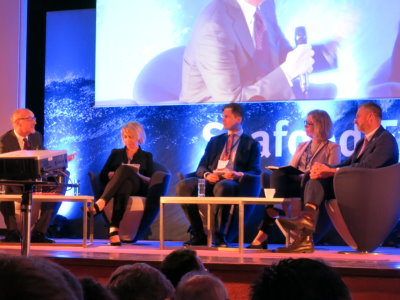 An independent scientific assessment of Northeast Atlantic fisheries for which sufficient data were available and published in 2016 already pointed to a configuration characterised by conflict of interest of a structural nature. This had led to new or maintained unjustified certifications in more than 30% of unjustified cases (10 out of 31). The study found certification was not withdrawn that in several cases even though the fisheries did not fulfil the conditions set to keep the label, which had initially been granted as a sort of “incentive” to comply with sustainability criteria. The most essential certification criteria are:
An independent scientific assessment of Northeast Atlantic fisheries for which sufficient data were available and published in 2016 already pointed to a configuration characterised by conflict of interest of a structural nature. This had led to new or maintained unjustified certifications in more than 30% of unjustified cases (10 out of 31). The study found certification was not withdrawn that in several cases even though the fisheries did not fulfil the conditions set to keep the label, which had initially been granted as a sort of “incentive” to comply with sustainability criteria. The most essential certification criteria are:
- no overfishing – sustainable stocks
- low impact fishing with minimal damage to the environment and ecosystems
- good management.
The documentary about the dark side of MSC screened in the first channel of public German tv the night before the Seafood Fair illustrated powerfully the erosion of the original mandate that actually confers unfair commercial advantages on companies that do not play by the rules. This is felt particularly strongly in countries like Germany, Switzerland, UK and Austria where the major food retailers already source most of their products on the basis of the blue label. More than a million people had seen the documentary and were concerned that they could not rely on MSC anymore.
During the panel discussion, MSC boss Rupert Howes explained that MSC should not set the bar higher than what the industry could achieve and that it was more important to achieve small incremental improvements in a large part of the industry than insisting on all original criteria which would not or could not be met. Panelist Thor Bjørklund Larsen from Norway drew attention to the already high cost of the certification process that only subsidised fisheries in rich countries could meet increasing the trade barriers to all others in the global market.
That obviously begs the question of the continued usefulness of MSC if it were giving up on pushing for sustainability in fisheries, quite aside from the above-mentioned abuse of consumer trust. The participants would not get an answer on this fundamental question and went away with a feeling of doubt, especially in the light of reiterated ambition by Nicolas Guichoux of MSC to expand certification by all means to 30% of world fisheries by 2030.
The coalition Make Stewardship Count
 The rapidly growing coalition of conservation organisations and concerned individuals collaborating towards a reform of MSC on the “Make Stewardship Count” platform has meanwhile grown to 76 partners. It conducted a representative consumer study in several countries where the blue label is strongly represented. That clearly showed that consumers want sustainability assurance and therefore look for the label. Their trust must not be disappointed. The coalition Make Stewardship Count issued immediately a news release to share and comment on the essentials of the survey.
The rapidly growing coalition of conservation organisations and concerned individuals collaborating towards a reform of MSC on the “Make Stewardship Count” platform has meanwhile grown to 76 partners. It conducted a representative consumer study in several countries where the blue label is strongly represented. That clearly showed that consumers want sustainability assurance and therefore look for the label. Their trust must not be disappointed. The coalition Make Stewardship Count issued immediately a news release to share and comment on the essentials of the survey.
That's a great responsibility for MSC itself and for the seafood retailers to make sure that they do not abuse the trust and expectations of citizens and consumers. The retailers are well-advised to demand that MSC delivers on its original promise or they risk disgruntled customers.
It is also a wake-up call for public authorities not to wiggle out of their fundamental rule setting and enforcement responsibility as the “market” clearly does not solve the problem of overfishing by itself. On the contrary, unfortunately, the global competition and lax enforcement of existing rules is leading to ever more criminal practices that has led Interpol to set up a special unit to fight organised transboundary crime in fisheries and associated crimes in human trafficking, arms and drugs.
Sustainability is still not a tangible factor in the Brussels Seafood Fair
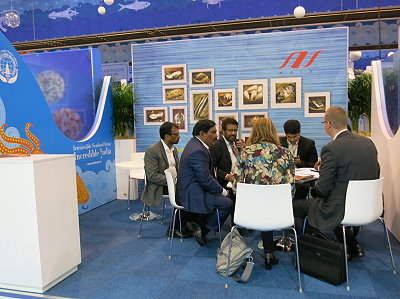 Wandering along the almost endless rows of company stands and seeing the suited old men putting their heads together in negotiation, few were the booths putting emphasis on sustainable, low impact catches. Power of machinery, freshness, taste and nice visual presentation were the trump cards at the booths. These are doubtlessly good criteria. But you ask yourself why sustaining good and healthy future production does not play a very visible role in the way companies, regions and countries present themselves to the critical and expert eyes of the commercial public?
Wandering along the almost endless rows of company stands and seeing the suited old men putting their heads together in negotiation, few were the booths putting emphasis on sustainable, low impact catches. Power of machinery, freshness, taste and nice visual presentation were the trump cards at the booths. These are doubtlessly good criteria. But you ask yourself why sustaining good and healthy future production does not play a very visible role in the way companies, regions and countries present themselves to the critical and expert eyes of the commercial public?
One may wonder, where all the raw produce is coming from offered for sale by the countless Chinese, Korean, Turkish, Spanish and other countries' booths. It is sheer impossible to source all this in their own waters.
Our own field research in West Africa and the substantial body of work published by the Sea Around Us Project on reconstructing real catches compared to what countries report to FAO suggests that a lot of these catches are unaccounted for. When they are made by long-distance fleets which may transship at sea out of sight of authorities in developing countries one can not but be concerned about what that means for the livelihoods of local small-scale fishers and food security of millions.
Of course, the dark side of the industry is artfully hidden behind aesthetic displays and tasty fingerfood or discrete receptions in the catering building. We just stumbled over an example with Congeladora Velazquez s.a. de cv from Mexico showing its frozen seafood for sale to interested buyers. Of course, this was not the place to mention that a shipment of frozen shark fin including a substantial part of fins of CITES protected species had just been intercepted at Frankfurt airport, while the bulk of two tons was dutifully delivered to its Asian destination. How many of these slow growing predators have been taken out of the ecosystem they keep normally in check? Two tons of fins make a lot of whole sharks, but this is at best the tip of the proverbial iceberg of shark finning going on in the seas.
Text and pictures by Cornelia E Nauen.
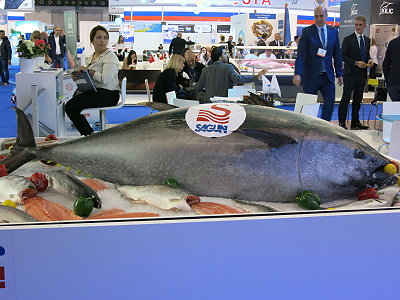 |
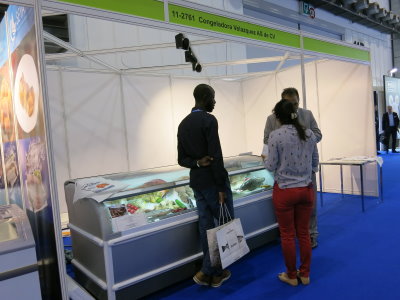 |
 |
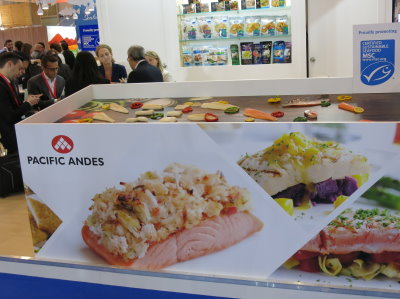 |
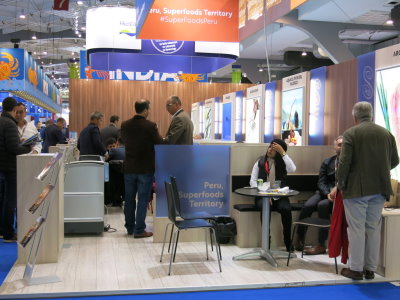 |
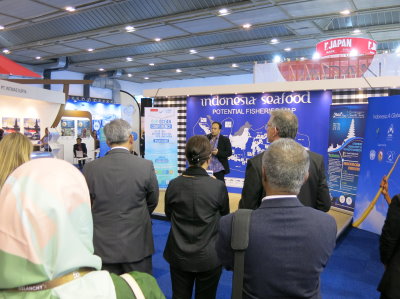 |








